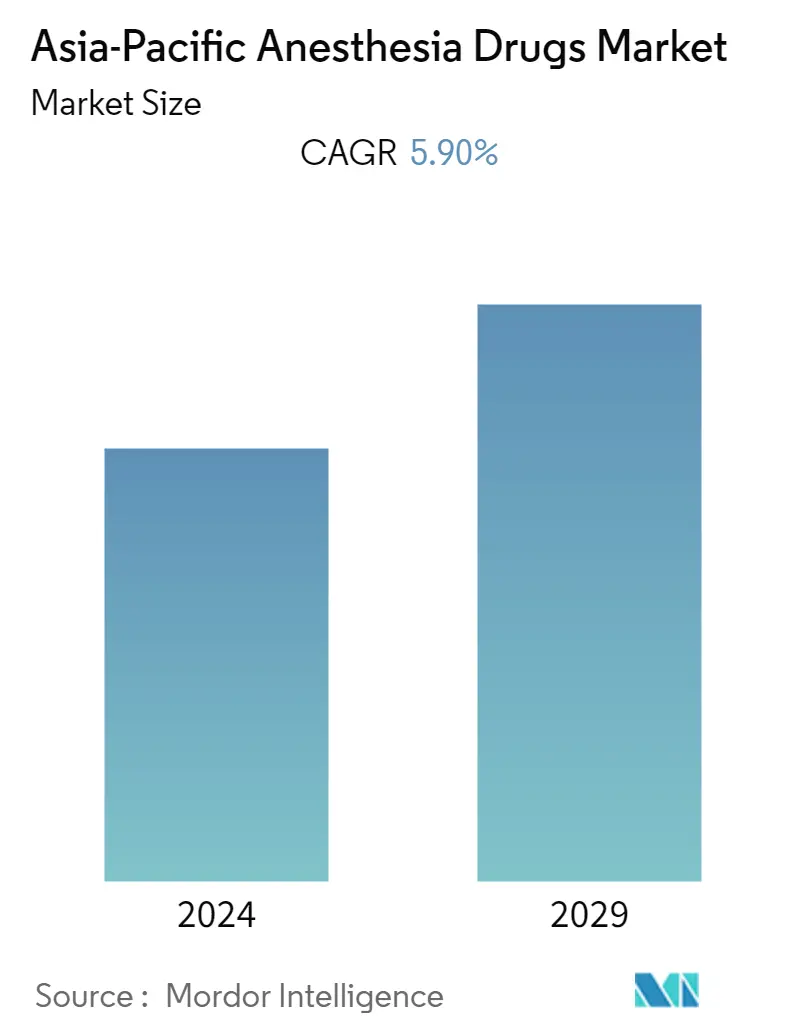Market Size of Asia-Pacific Anesthesia Drugs Industry

| Study Period | 2019 - 2029 |
| Base Year For Estimation | 2023 |
| Forecast Data Period | 2024 - 2029 |
| Historical Data Period | 2019 - 2022 |
| CAGR | 5.90 % |
Major Players
*Disclaimer: Major Players sorted in no particular order |
APAC Anesthetic Drugs Market Analysis
The market for anesthesia drugs in Asia and the Pacific is expected to register a CAGR of 5.9% over the next few years.
COVID-19 impacted the growth of the anesthesia drugs market in the region. Surgery postponements or cancellations that occurred during the pandemic resulted in a modest drop in anesthetic drug demand. For instance, according to an article published in NCBI, in May 2020, about 5.8 lakh elective surgeries were postponed in India due to lockdown and other restriction measures imposed by the government. Thus, the delayed elective surgery cases impacted the demand for anesthesia drugs in the region during the pandemic. However, with the released restrictions, the number of surgical procedures resumed, which increased the demand for general and local anesthesia drugs. Thus, the studied market is expected to bounce back to its full potential in the coming years.
Factors such as the increasing geriatric population, a rise in the number of surgical procedures requiring anesthesia, the rising number of patients due to chronic diseases, and growing anesthesia product approvals are boosting market growth.
The rising prevalence and incidence of chronic diseases among the population, coupled with the increasing geriatric population, is the key factor driving the market's growth. For instance, according to the Australian Bureau of Statistics, in March 2022, the prevalence of heart disease in Australia was 4.0%, down from 4.0% in 2020-2021, which equates to about 1 million people. Also, according to the 2022 statistics published by UNPF, about 68% of the population living in Asia-Pacific was aged between 15 and 64 years old in 2022, and 9% of the population was aged 65 years and older in 2022. Thus, the increasing burden of cancer and heart disease increases the need for surgical procedures, which in turn is anticipated to fuel the demand for anesthetic drugs. This is anticipated to drive market growth over the forecast period.
Additionally, the increasing number of surgeries raises the demand for anesthetic drugs, which in turn is expected to fuel market growth. For example, Hexahealth published a report in October 2022 estimating that 60,000 bypass surgeries are performed in India each year.According to a study published in the Journal of Orthopaedic Science, by 2030, approximately 4,052 knee arthroplasties will be performed on men between the ages of 40 and 64, 6,942 on men between the ages of 65 and 74, and 14,986 on men over 75 in Japan.In addition, as per the same source, about 7,092 knee arthroplasty procedures are expected to be performed on women between the ages of 40 and 64 years, 22,957 on women between the ages of 65 and 74 years, and 58,340 on women over 75 years in Japan by 2030. Thus, the expected increase in the number of surgical procedures raises the demand for local and general anesthesia during surgical procedures, which in turn is anticipated to bolster the market's growth over the forecast period.
Therefore, owing to factors such as the increasing geriatric population, growing number of surgical procedures, and high burden of chronic diseases, as well as increasing product launches, the studied market is expected to grow over the forecast period. However, the side effects of general anesthesia and strict government regulations regarding product approvals are likely to impede the growth of the anesthesia drugs market in the Asia-Pacific region over the forecast period.
APAC Anesthetic Drugs Industry Segmentation
As per the scope of the report, anesthesia is a drug that induces a reversible loss of sensation. Anesthesia is one of the essential components of any surgical procedure. It induces temporary unconsciousness and loss of protective reflexes. General anesthesia drugs suppress the activities of the central nervous system and induce a complete lack of sensation. Local anesthetics restrict the transmission of nerve impulses from the targeted region to the spinal cord. There are several types of anesthetic drugs available in the market, such as general anesthesia, spinal anesthesia, IV regional anesthesia, local anesthesia, peripheral nerve block, and saddle block or caudal anesthesia. The Asia-Pacific Anesthesia Drugs Market is Segmented by Drug Type (General Anesthesia Drugs and Local Anesthesia Drugs), Route of Administration (Inhalation, Injection, and Other Routes of Administration), Application (General Surgery, Plastic Surgery, Cosmetic Surgeries, Dental Surgeries, and Other Applications), and Geography. The report offers the value (in USD Million) for the above segments.
| By Drug Type | |||||||||
| |||||||||
|
| By Route of Administration | |
| Inhalation | |
| Injection | |
| Other Routes of Administration |
| By Application | |
| General Surgery | |
| Plastic Surgery | |
| Cosmetic Surgery | |
| Dental Surgery | |
| Other Applications |
| Geography | |
| China | |
| Japan | |
| India | |
| Australia | |
| South Korea | |
| Rest of Asia-Pacific |
Asia-Pacific Anesthesia Drugs Market Size Summary
The Asia-Pacific anesthesia drugs market is poised for significant growth, driven by an increasing geriatric population, a rise in surgical procedures, and a high burden of chronic diseases. The market experienced a temporary setback due to the COVID-19 pandemic, which led to the postponement of elective surgeries and a subsequent dip in anesthetic drug demand. However, as restrictions eased and surgical activities resumed, the market began to recover. The growing prevalence of chronic conditions such as cancer and cardiovascular diseases, coupled with the rising number of surgeries, is expected to fuel the demand for anesthesia drugs. Additionally, the approval of new anesthesia products is further propelling market expansion. Despite these positive trends, challenges such as the side effects of general anesthesia and stringent government regulations regarding product approvals may hinder market growth.
The propofol segment is anticipated to witness substantial growth due to its widespread use in surgical procedures and critical care settings. Propofol's short-acting nature and its role in procedural sedation and general anesthesia make it a preferred choice among healthcare providers. The introduction of propofol analogs with improved properties is also contributing to the segment's expansion. The increasing number of clinical trials and research studies is expected to further boost the adoption of propofol and its analogs. In India, the rising incidence of chronic diseases and the growing elderly population are key factors driving the demand for anesthesia drugs, with a particular emphasis on propofol. The presence of both global and regional players in the market underscores its lucrative potential, especially in developing economies with high unmet medical needs.
Asia-Pacific Anesthesia Drugs Market Size - Table of Contents
-
1. MARKET DYNAMICS
-
1.1 Market Overview
-
1.2 Market Drivers
-
1.2.1 Increasing Geriatric Population and a Rise in the Number of Surgical Procedures Requiring Anesthesia
-
1.2.2 Large Patient Pool Due to Chronic Diseases
-
1.2.3 New Anesthesia Product Approvals
-
-
1.3 Market Restraints
-
1.3.1 Side Effects of General Anesthetics
-
1.3.2 Regulatory Issues
-
-
1.4 Porter's Five Forces Analysis
-
1.4.1 Threat of New Entrants
-
1.4.2 Bargaining Power of Buyers/Consumers
-
1.4.3 Bargaining Power of Suppliers
-
1.4.4 Threat of Substitute Products
-
1.4.5 Intensity of Competitive Rivalry
-
-
-
2. MARKET SEGMENTATION (Market Size - Value in USD million)
-
2.1 By Drug Type
-
2.1.1 General Anesthesia Drugs
-
2.1.1.1 Propofol
-
2.1.1.2 Sevoflurane
-
2.1.1.3 Desflurane
-
2.1.1.4 Dexmedetomidine
-
2.1.1.5 Remifentanil
-
2.1.1.6 Midazolam
-
2.1.1.7 Other Drug Types
-
-
2.1.2 Local Anesthesia Drugs
-
2.1.2.1 Bupivacaine
-
2.1.2.2 Ropivacaine
-
2.1.2.3 Lidocaine
-
2.1.2.4 Chloroprocaine
-
2.1.2.5 Prilocaine
-
2.1.2.6 Benzocaine
-
2.1.2.7 Other Local Anesthesia Drugs
-
-
-
2.2 By Route of Administration
-
2.2.1 Inhalation
-
2.2.2 Injection
-
2.2.3 Other Routes of Administration
-
-
2.3 By Application
-
2.3.1 General Surgery
-
2.3.2 Plastic Surgery
-
2.3.3 Cosmetic Surgery
-
2.3.4 Dental Surgery
-
2.3.5 Other Applications
-
-
2.4 Geography
-
2.4.1 China
-
2.4.2 Japan
-
2.4.3 India
-
2.4.4 Australia
-
2.4.5 South Korea
-
2.4.6 Rest of Asia-Pacific
-
-
Asia-Pacific Anesthesia Drugs Market Size FAQs
What is the current Asia-Pacific Anesthesia Drugs Market size?
The Asia-Pacific Anesthesia Drugs Market is projected to register a CAGR of 5.90% during the forecast period (2024-2029)
Who are the key players in Asia-Pacific Anesthesia Drugs Market?
AbbVie Inc, Aspen Holdings, Baxter International, Fresenius SE & Co. KGaA and B. Braun SE are the major companies operating in the Asia-Pacific Anesthesia Drugs Market.

